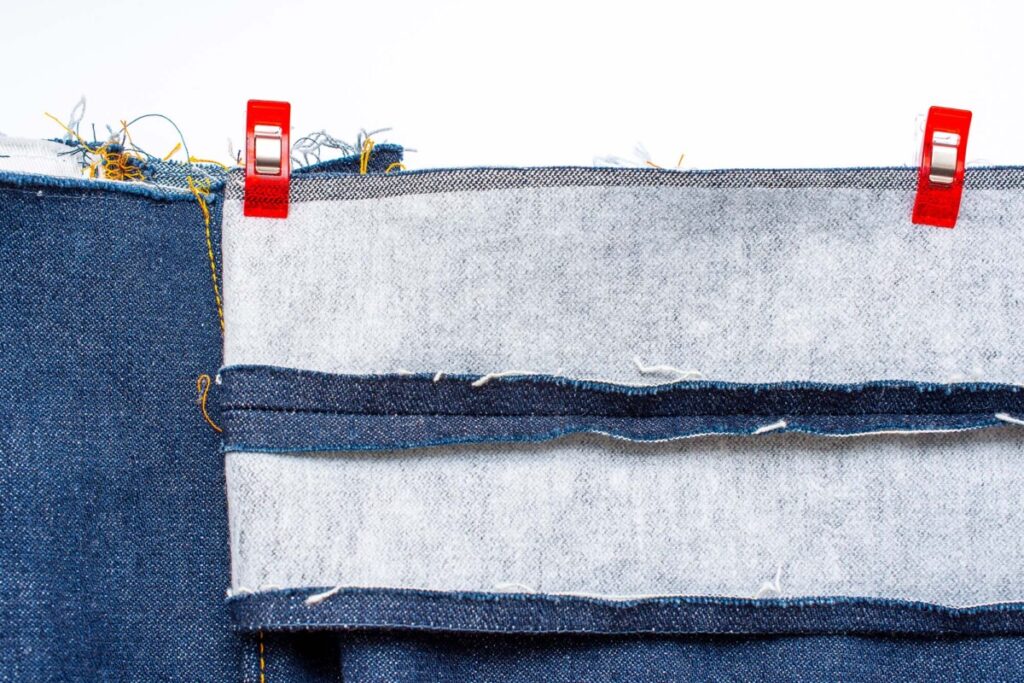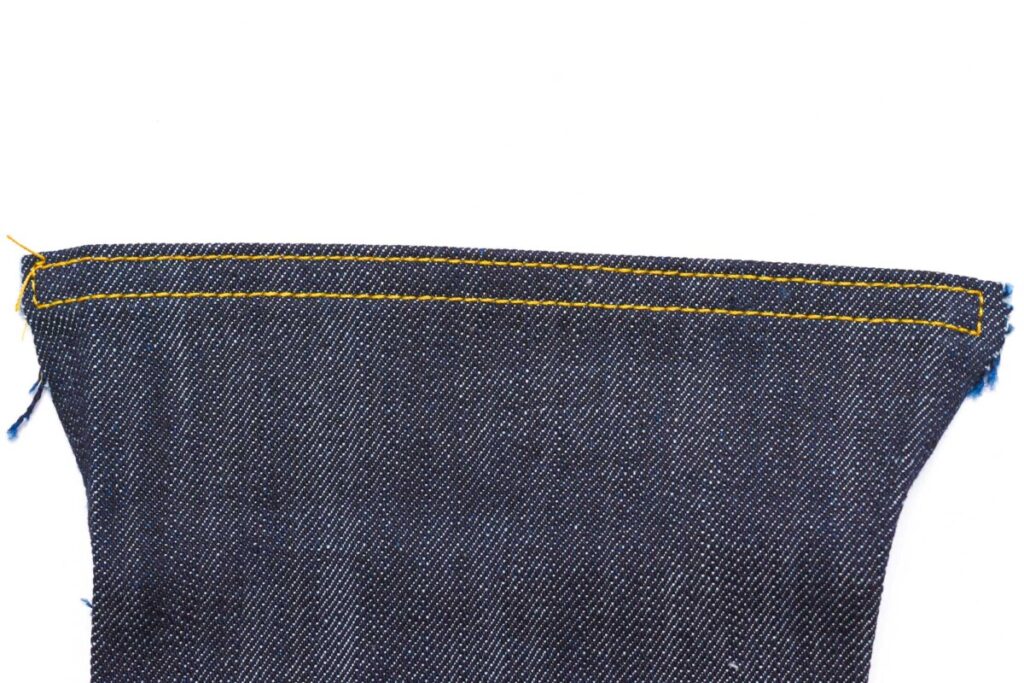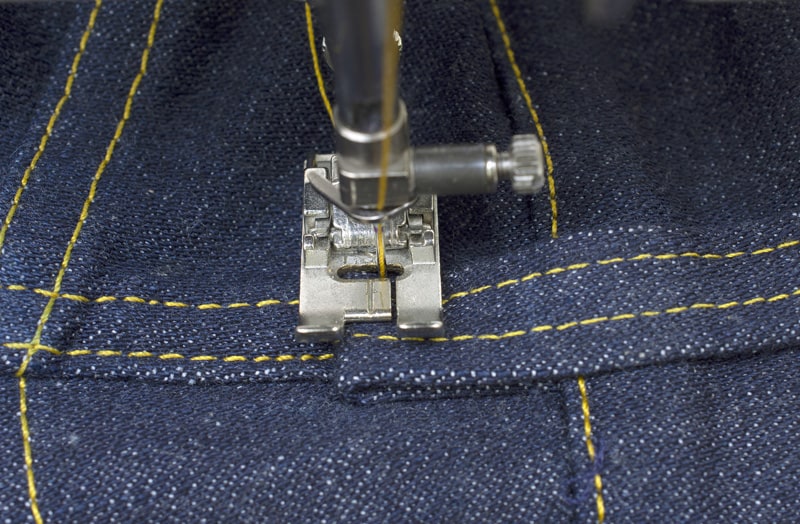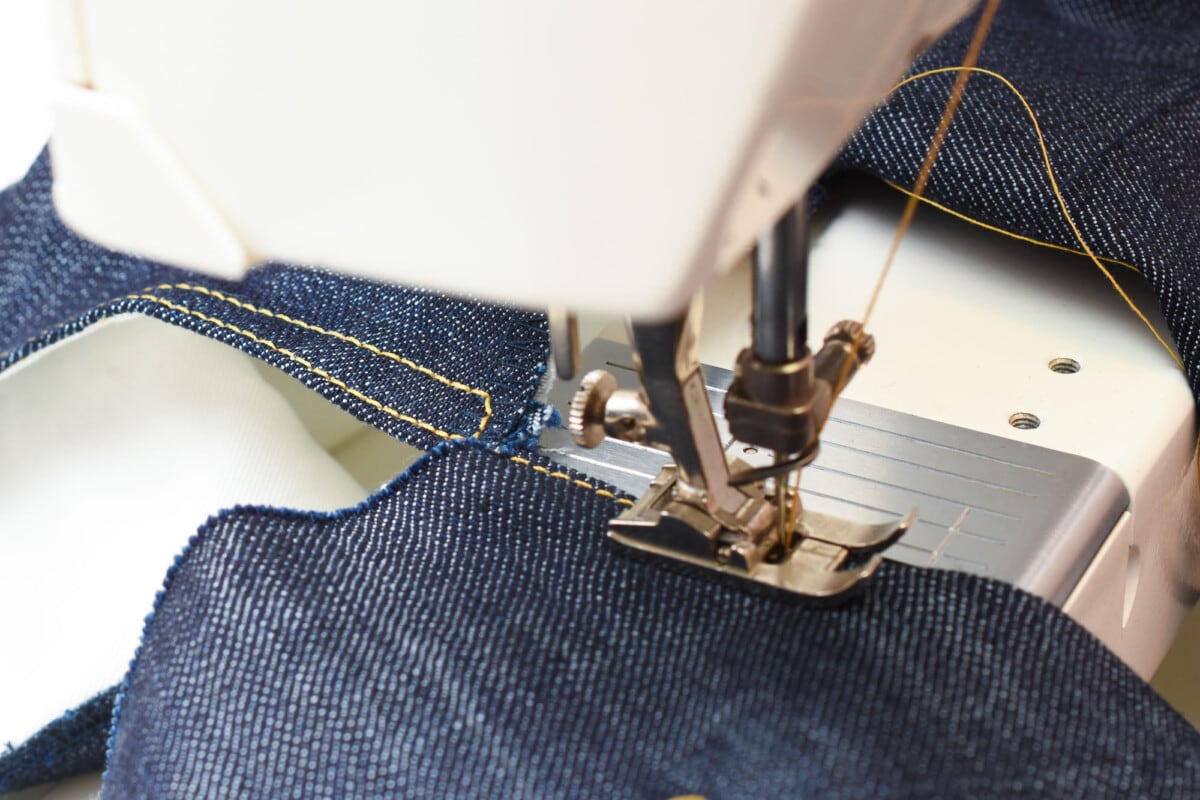
Love sewing jeans, but feel a bit overwhelmed by how long they take to make, not to mention all the times you have to change the set-up on your machine? I totally hear you! Which is why I want to share seven of my favourite time-saving tips for sewing jeans.
Now before we start, I do want to emphasis that sewing jeans is generally not a quick project, especially when you factor in things like cutting, fitting and prepping.
I’m also not a fan of encouraging speedy sewing, since I think it can lead to more mistakes and also paint an unrealistic picture of how much time a project actually takes for us home sewists.
However, there are some sensible ways to streamline the jeans making process, which I will show you here (and please share your tips too in the comment section).

1. Batch cut and fuse interfacing
This might sound like a no-brainer, but I know many sewists (including myself) who sometimes skip cutting and fusing all the interfacing first thing. And that kinda messes up the workflow once you get started sewing.
Ideally, try to cut out all the interfacing while also cutting the fabric. And then batch fuse all the pieces that need interfacing. For jeans, that is usually the waistband, fly facing and fly-shield, especially if the denim is on the lighter side.

2. Organise your notions
Before I start sewing, I put all the stuff I need in one place. I’m currently using a metal candy tin since it is low and the perfect size for what I need.
In there I put thread spools, bobbin thread, needles, hump-jumpers, presser feet and other things that I will need regularly while sewing the jeans. And I make sure that I put everything back in the tin when I’m not needing that particular notion.
Bonus tip: Wind two bobbins with the same thread, so if you are topstitching a long sequence and are unsure if the bobbin thread will last, just switch to the fully winded one. This will save you from having to rip up a tonne of thread and start over if you run out bobbin thread mid-way.
Read more about: 8 Great Tools and Notions for Sewing Jeans

3. Skip overcasting on enclosed seams
There is no need to overcast edges that are being enclosed and stitched over, they don´t do that in factories, and you can skip it too (unless you want to overcast everything).
Examples
- Waistband
- Back pocket
- Front pocket opening
- Upper edges of the jeans (that are being enclosed in the waistband)
- Hem
- Belt loops


4. Overcast several layers at the same time
Seams that are being topstitched can be overcast after they’ve been sewn together. This both saves time and minimise unnecessary bulk. And requires less thread too!
Examples
- Back crotch
- Yoke
- Inner our outer side seams
In my book Sewing Jeans, I go more into detail on where and when to overcast the edges. I also show how to sew flat-felled seams, which eliminates the need for overcasting.

5. Chain piece
This means sewing several pieces at once without stopping and cutting the thread. It’s very common in quilting and factory sewing, and it can be done on jeans too. For instance, when topstitching the front pocket openings, insert the second pocket and just keep sewing.

The only issue with this method is securing the stitch, so either backstitch a tiny bit in the beginning and end, or decrease the stitch length substantially to secure. There is no need for going overboard with securing the seams though since the pieces will be sewn together afterwards. For instance, the front pockets will be part of both the side and waistband seams and thus secured that way too.
Learn more tips: 10 Tips for Sewing Jeans

6. Topstitch in one continuous sequence
This means that you’ll topstitch both rows as one continuous sequence, starting and finishing at the same spot. This also removes the need for excessive securing, since the stitch will overlap. Just start and stop with a shorter stitch length, and you’ll be fine.

In my book Sewing Jeans I show step-by-step instructions for how this can be done, using diagrams with the best stitching order for each piece. This is actually one of my favourite time-saving tips for sewing jeans, and something that is very common in the garment industry.
Areas that can be topstitched as a sequence
- Front pocket openings
- Back pocket
- Key (5th) pocket
- Yoke
- Back and front crotch seam
- Zipper fly

7. Batch sew
If you are new to sewing jeans, I do recommend finishing one part before moving on to the next area, meaning you should finish all the front pocket steps before moving on to the fly. Focusing on one thing at the time both will help to improve your skills and also minimises the risk for errors.
The downside of that method is that it requires rethreading and reconfiguring the machine several times, as you are switching back and forth between topstitching, and sewing together seams.
So if you are feeling confident and really hate constant rethreading, you can topstitch or sew together several different pieces in one go.
Topstitch batching
- Front pocket opening, back pockets and back crotch
- Waistband and hem
Seam batching
- Pockets opening and yoke
- Outer side seams and waistband
Bartack batching
- Back pockets, fly and belt loops

So these are seven of my best time-saving tips for sewing jeans and streamlining the jeans making process. As I mention, some of the tips are a bit more advanced, so if you are new to jeans sewing, don’t focus too much on saving a couple of minutes here and there. So start slow and be methodical. Once you have a few jeans under your belt, you can start experimenting with things like batch and chain piercing.
Remember that we are sewing primarily for pleasure and creative fulfilment, so unless speed is your jam, there is no need to act like an assembly line worker racing against the clock. Most of us have enough stress in our lives already, so why adding that to our sewing time too?
So instead of sewing faster, focus on sewing smarter, which can often save time too. Now I would love to hear your best time saving and optimising tips!





11 Comments
Cathy
Great tips, thank you. Do you ever use a twin needle for the topstitching on jeans?
Leslie A Coduti
This would depend upon whether or not you are using top stitch thread or 2 spools of regular thread per needle as well as how fussy you are about how the reverse side of your topstitching will look. Also consider what would you do at a corner? I personally do not like the idea of crossing my threads. Think about how heavy duty your machine is. 2 needles going through fabric vs only one may not be as easy on the machine,
Cecilia Nilsson
The way I look at it, I don’t mind that a project takes time, I try rather to sew mindfully, do it properly, learn from the experience and enjoy the sewing journey. Once finished, I’ll just start another project anyway so it can get expensive 🙂 and I”m stuck with perhaps not the result I wanted.
Patt
I have made 2 pairs of jeans both became pull ons because I have no waist and a flat butt. I don’t want to go the extra work of the fly and waistband. I have not used top stitching thread or doubled the thread for top stitching. I should have since my top stitching barely shows. What is your favorite thread to use for top stitching? Do you use a coverstitch for the top stitching?
Sheri
I’m looking for blog posts on fitting and sewing fitted jeans made with stretch denim. Do you have such posts? If so, can you point me to them?
Sheri
Or does your jeans sewing book cover this? I’m not finding the information in the description.
Comments are closed.